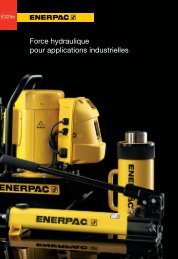Hydraulic Power for all Industrial Applications
Hydraulic Power for all Industrial Applications
Hydraulic Power for all Industrial Applications
Create successful ePaper yourself
Turn your PDF publications into a flip-book with our unique Google optimized e-Paper software.
Valve In<strong>for</strong>mation<br />
Ways<br />
The (oil) ports on a valve.<br />
A 3-way valve has 3 ports:<br />
pressure (P), tank (T), and cylinder (A).<br />
A 4-way valve has 4 ports:<br />
pressure (P), tank (T), advance (A) and<br />
retract (B).<br />
Single-Acting cylinders require at least<br />
a 3-way valve, and can, under certain<br />
instances, be operated with a 4-way valve.<br />
Double-Acting cylinders require a 4-way<br />
valve, providing control of the flow to each<br />
cylinder port.<br />
Positions<br />
The number of control points a valve can<br />
provide. A 2-position valve has the ability to<br />
control only the advance or retraction of the<br />
cylinder. To be able to control the cylinder<br />
with a hold position, the valve requires a<br />
3rd position.<br />
Centre Configuration<br />
The centre position of a valve is the position<br />
at which there is no movement required of<br />
the hydraulic component, whether a tool or<br />
cylinder.<br />
A<br />
The most common is the<br />
Tandem Centre. This<br />
PT<br />
configuration provides <strong>for</strong><br />
little to no movement of the cylinder and the<br />
unloading of the pump. This provides <strong>for</strong><br />
minimum heat build-up.<br />
AB<br />
The next most common<br />
is the Closed Centre<br />
PT<br />
configuration, which is used<br />
mostly <strong>for</strong> independent control of multicylinder<br />
applications. This configuration<br />
again provides <strong>for</strong> little to no movement of<br />
the cylinder, but also dead-heads the<br />
pump, isolating it from the circuit.<br />
Use of this type of valve may require some<br />
means of unloading the pump to prevent<br />
heat build-up.<br />
There are many more type of valves, such<br />
as Open Centre and Float Centre.<br />
These valves are used mostly in complex<br />
hydraulic circuits and require other special<br />
considerations.<br />
AB<br />
PT<br />
Open<br />
Centre<br />
AB<br />
PT<br />
Float<br />
Centre<br />
120 © Enerpac<br />
Directional<br />
Control<br />
Valves<br />
Valves may<br />
be either<br />
pump<br />
mounted or<br />
remote<br />
mounted.<br />
Valves may<br />
be either<br />
manu<strong>all</strong>y or<br />
solenoid<br />
operated.<br />
Advance<br />
Hold<br />
Retract<br />
3-Way Valves<br />
are used with single-acting<br />
cylinders<br />
Pump Mounted<br />
A Advance<br />
P<br />
The oil flows<br />
from the pump<br />
pressure port<br />
P to the<br />
cylinder port A: the cylinder<br />
plunger will extend.<br />
A Hold<br />
P T The oil flows<br />
from the pump<br />
pressure port<br />
P to the tank<br />
T. The cylinder port A is<br />
closed: the cylinder plunger<br />
will maintain its position.<br />
A Retract<br />
P T The oil flows<br />
from the<br />
pump and<br />
cylinder port A<br />
to the tank T: the cylinder<br />
plunger will retract.<br />
;@À;@À;@À;@À;@À;@À;@À;@À;@À;@À;@À;@À;@À;@À;@À;@À;Q¢ ;@À;@À;@À;@À;@À;@À;@À;@À;@À;@À;@À;@À;@À;@À;@À;@À;Q¢<br />
;@À;@À;@À;@À;@À;@À;@À;@À;@À;@À;@À;@À;@À;@À;@À;@À;Q¢<br />
;@À;@À;@À;@À;@À;@À;@À;@À;@À;@À;@À;@À;@À;@À;@À;@À;Q¢<br />
<strong>Hydraulic</strong> Technology Worldwide<br />
4-Way Valves<br />
are used with double-acting<br />
cylinders<br />
Remote Mounted<br />
Manu<strong>all</strong>y Operated Solenoid Operated<br />
Single-acting cylinder<br />
Controlled by a 3-way,<br />
3-position valve.<br />
; @À<br />
; @À<br />
; @À<br />
; @À<br />
; @À<br />
; @À<br />
; @À<br />
; @À<br />
; @À<br />
; @À<br />
; @À<br />
; @À<br />
; @À<br />
; @À<br />
; @À<br />
; @À<br />
; Q¢<br />
; @À<br />
; @À<br />
; @À<br />
; @À<br />
; @À<br />
; @À<br />
; @À<br />
; @À<br />
; @À<br />
; @À<br />
; @À<br />
; @À<br />
; @À<br />
; @À<br />
; @À<br />
; @À<br />
; Q¢<br />
Double-acting cylinder<br />
Controlled by a 4-way,<br />
3-position valve.<br />
A Advance<br />
P T The oil flows<br />
from the pump<br />
B pressure port<br />
P to the<br />
cylinder port A and from<br />
cylinder port B to tank T.<br />
A Hold<br />
P T The oil flows<br />
from the pump<br />
B pressure port P<br />
to the tank T.<br />
The cylinder ports A and B are<br />
closed: the cylinder plunger<br />
will maintain position.<br />
A Retract<br />
P T The oil flows<br />
from the pump<br />
B pressure port<br />
P to cylinder<br />
port B and from cylinder port<br />
A to tank T: the cylinder<br />
plunger will retract.<br />
www.enerpac.com<br />
;@À;@À;@À;@À;@À;@À;@À;@À;@À;@À;@À;@À;@À;@À;@À;@À;Q¢<br />
;@À;@À;@À;@À;@À;@À;@À;@À;@À;@À;@À;@À;@À;@À;@À;@À;Q¢






